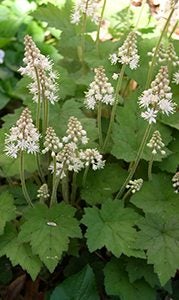Wildflower of the Month
Published 1:47 pm Tuesday, June 19, 2018
|
Getting your Trinity Audio player ready...
|
Foamflower makes great ground-cover
Foamflower
Tiarella cordifolia
A very pretty flower with a light, airy character, foamflower blooms across Virginia from April through July in habitat simulating its native moist woods. It can tolerate sun to shade, but needs moisture and rich, loamy soil. Using a few rocks at the site helps to maintain cool roots. If the plant appreciates its site, there will soon be a colony of foamflowers thanks to wandering rhizomes.

In the 1850s, country people used the leaves of foamflowersfor healing purposes, placing them on scalds and burns.
This is a perennial with maple-like leaves, and flowers that bloom in a spike up to six inches long on a leafless stalk up to 14 inches high. Foamflower makes a great ground-cover for the shade garden. The white flower spikes are pyramidal and float above the leaves, which are mostly clustered at the base of the plant. When planted in mass it resembles a sea of foam. This semi-evergreen perennial has great fall interest when its leaves have turned to burgundy hues. Plant it in moist shade with ferns and colorful counterparts such as cardinal flower, geranium, phlox, fire pink, celandine poppy and crested iris.
In the 1850s, country people used its leaves for healing purposes, placing them on scalds and burns. The Shakers prepared the herb for sale as a diuretic and tonic. Native Americans used the leaves in a tea as a mouthwash and treatment of eye discomforts.
The genus name is Latin for “little tiara,” referring to the shape of the fruit and the species name cordifolia refers to the heart-shaped leaf base.
In Virginia, foamflower is well-represented in the mountain provinces and adjacent Piedmont. It has been documented only from James City County in the Coastal Plain, where it grows along creek banks in deep ravines.
HELEN HAMILTON is past president of the John Clayton Chapter, Virginia Native Plant Society. Contact her at helen48@cox.net. For more information about native plants, visit www.vnps.org.

